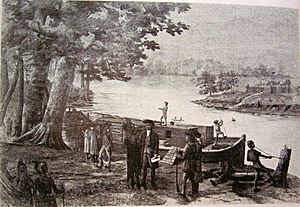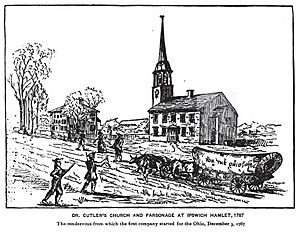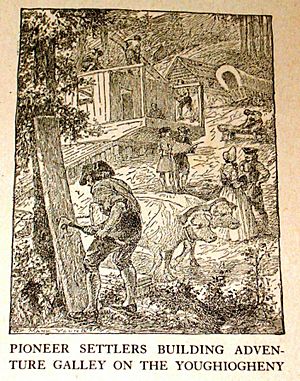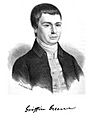List of early settlers of Marietta, Ohio facts for kids

"General Putnam landing at Marietta"
|
|
| Date | April 7, 1788 |
|---|---|
| Location | Marietta, later part of the U.S. state of Ohio |
| Outcome | Founding of the first permanent American settlement of the Northwest Territory |
This article is about the early settlers of Marietta, Ohio. Marietta was the very first permanent town created by United States citizens. This happened after the Northwest Territory was officially set up in 1787. The people who settled there included brave soldiers from the American Revolutionary War and members of a group called the Ohio Company of Associates.
Contents
How Marietta Was Settled
The first group of settlers is often called "the forty-eight" or the "first forty-eight." They are also known as the "founders of Ohio." These 48 men were carefully chosen by the leaders of the Ohio Company, Rufus Putnam and Manasseh Cutler. They wanted to make sure the men were honest, brave, and had the skills needed to build a town in the wilderness.
George Washington himself said about them: "I know many of the settlers personally, and there never were men better calculated to promote the welfare of such a community." General Lafayette, a French hero who helped America in the Revolutionary War, visited Marietta in 1825. He called these pioneers and former officers: "They were the bravest of brave. Better men never lived."
The Journey West


Led by Rufus Putnam, two groups of pioneers, making up the first 48 men, left New England. They cut new paths through the mountains during a very cold winter. One group left from Ipswich, Massachusetts and Danvers, Massachusetts on December 3, 1787. The other group left from Hartford, Connecticut on January 1, 1788.
The pioneers crossed the mountains and met at Sumrill's Ferry, which is now West Newton, Pennsylvania. It was located on the Youghiogheny River. During the freezing winter, the men built three log canoes and two flatboats. They also built a larger 45-ton boat called the Adventure Galley. This boat was also known as the Mayflower, named after the famous ship of the Pilgrim ancestors. They also built a smaller three-ton boat called the Adelphia.
This small fleet of boats carried the pioneers down the Youghiogheny River to the Monongahela River. From there, they traveled to the Ohio River, and then continued into the Ohio Country and the Northwest Territory. They finally reached their destination on April 7, 1788. This spot was where the Muskingum River meets the Ohio River.
The First Forty-Eight Settlers
Most of the first 48 pioneers arrived on April 7, 1788. A few arrived a bit later in April. Here are some of the important men in this group:
- General Rufus Putnam, who was in charge of the settlement and helped start the Ohio Company of Associates.
- Colonel Return J. Meigs Sr., a surveyor who measured the land.
- Colonel Ebenezer Sproat, another surveyor. He was married to the daughter of Commodore Abraham Whipple.
- Major Anselm Tupper, also a surveyor. He was the son of General Benjamin Tupper.
- John Mathews, a surveyor.
- Major Haffield White, who was the quartermaster, in charge of supplies.
- Captain Ezekiel Cooper
- Captain Daniel Davis
- Captain Jonathan Devoll (Devol)
- Captain Peregrine Foster
- Captain William Gray
- Captain Josiah Munroe (Munro)
- Captain Jethro Putnam
- Jabez Barlow
- Daniel Bushnell
- Phineas Coburn
- Ebenezer Corey (Cory)
- Samuel Cushing
- Jarvis (Jervis) Cutler, who was the son of Manasseh Cutler.
- Israel Danton
- Jonas Davis
- Allen Devoll
- Gilbert Devoll, Jr.
- Isaac Dodge
- Oliver Dodge
- Samuel Felshaw
- Hezekiah Flint
- Hezekiah Flint, Jr.
- John Gardner
- Benjamin Griswold
- Elizur (Elisur) Kirtland
- Theophilus Leonard (Learned)
- Joseph Lincoln
- Simeon Martin
- Henry Maxom
- William Maxom (Mason)
- William Miller
- William Moulton
- Edmond (Edmund) Moulton
- Amos Porter, Jr.
- Allen Putnam
- Benjamin Shaw
- Earl Sproat
- David Wallace (Wallis)
- Joseph Wells
- Josiah White
- Peletiah White
- Josiah Whitridge
More Settlers Arrive
More people arrived in Marietta in the months that followed.
May 1788 Arrivals
The following people arrived in May 1788:
- General Samuel Holden Parsons
- Colonel John May
- Colonel Israel Putnam, who was the son of General Israel Putnam.
- Colonel William Stacy
- Major Winthrop Sargent
- Captain William Dana
- Aaron Putnam
- Jonathan Stone
- Lisbeth
June 1788 Arrivals
In June 1788, more settlers came, including the very first woman settler:
- James Owen and his wife, Mary Owen, who was the first woman to settle there.
- Dr. Jabez True
- General James Varnum
August 1788 Arrivals
In August 1788, General Benjamin Tupper and his family arrived.
- General Benjamin Tupper, who also helped start the Ohio Company of Associates.
- Colonel Ichabod Nye and his wife Minerva Nye, who was General Tupper's daughter.
- Major Asa Coburn
- Andrew Webster
- The Cushing and Goodale families
Later Arrivals in 1788 and 1789
Other important people who arrived in 1788 and 1789 included:
- Quartermaster Griffin Greene, who was a cousin of General Nathanael Greene.
- Commander Abraham Whipple
The Legacy of the Pioneers
These early American pioneers helped open up the Northwest Territory for settlement. They are remembered for their courage and hard work.
In 1852, the president of the Ohio Historical Society described these pioneers. He said they had lived "various and eventful lives." They were born under a king, fought for America's freedom, and then moved into the wilderness. There, they helped create a new state, which grew to be almost as big as an empire. He called them "remarkable men" who were "energetic, industrious, persevering, honest, bold, and free."
In 1888, Senator George F. Hoar of Massachusetts spoke about them. He said they were an "illustrious band" of "exceptional character, talents and attainments." He also noted that they were "the best of New England culture" and "Revolutionary heroes."
These pioneers were well-trained from their army lives. They wanted to claim this land as payment for their military service. They had fought bravely to protect the ideas of their government. They also helped create the Ordinance of 1787, which set up the rules for governing the Northwest Territory. It is said that a better group of men could hardly have been chosen than those led by General Putnam.
The 48 people who stepped off the 'Adventure Galley' on April 7, 1788, came to the wilderness to start something great. They laid the foundation for one of the largest political structures that would protect millions of brave, successful, and happy free people. They were truly the founders of the states in the great Northwest. Within 50 years of their arrival, Ohio had 1.5 million people. It had also made fast progress in its roads, canals, laws, and public education. It became an example for some of the older states.
These early pioneers have been honored in poems and books. The poem Landing of the Pioneers was written 60 years after the landing by Frances Dana Gage. It was included in her book of poems published in 1867. The poem The Founders of Ohio was written in 1888 by William Henry Venable for the 100-year anniversary of the event. It was later published in several books of poems.
The book Pioneer History (1848) by Samuel Prescott Hildreth tells the early story of the Northwest Territory in Ohio. Hildreth's book Early Pioneer Settlers of Ohio (1852) shares life stories of the first settlers. Many of these early pioneers are buried in Marietta at Mound Cemetery. A film called Opening the Door West tells the story of the pioneers. It was shown on Ohio PBS in 2003 for Ohio's 200th birthday.
In 1888, a boat called the Adventure Galley III re-created the journey of the original pioneer 'Adventure Galley'. In 1984, this journey was done again aboard the Adventure Galley II (which was actually the fourth boat with that name, Adventure Galley). This Adventure Galley IV is now on display at the Behringer-Crawford museum in Cincinnati, Ohio.









